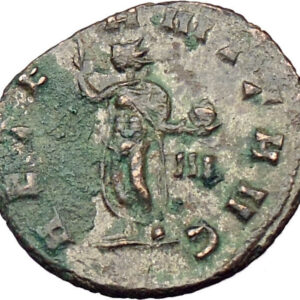|
Julia Mamaea – Augusta: 222-235 A.D.
Bronze Sestertius 29mm (18.06 grams) Rome mint, struck 226 A.D.
Reference: RIC 708; Cohen 8; Sear 8236
Certification: NGC Ancients VF Strike: 4/5 Surface: 4/5 4680613-008
IVLIA MAMAEA AVGVSTA, diademed & draped bust right.
VESTA S-C, Vesta standing left, holding Palladium & scepter.
You are bidding on the exact item pictured, provided with a Certificate of Authenticity and Lifetime Guarantee of Authenticity.
 Vesta was the virgin goddess of the hearth, home, and family in Roman religion. Vesta’s presence was symbolized by the sacred fire that burned at her hearth and temples. Vesta was the virgin goddess of the hearth, home, and family in Roman religion. Vesta’s presence was symbolized by the sacred fire that burned at her hearth and temples.
Vesta’s (in some versions she is called Vestia) fire was guarded at her Temples by her priestesses, the Vestales. Every March 1 the fire was renewed. It burned until 391, when the Emperor Theodosius I forbade public pagan worship. One of the Vestales mentioned in mythology was Rhea Silvia, who with the God Mars conceived Romulus and Remus (see founding of Rome).
The Vestales were one of the few full-time clergy positions in Roman religion. They were drawn from the patrician class and had to observe absolute chastity for 30 years. It was from this that the Vestales were named the Vestal virgins. They could not show excessive care of their person, and they were not allowed to let the fire go out. The Vestal Virgins lived together in a house near the Forum (Atrium Vestae), supervised by the Pontifex Maximus. On becoming a priestess, a Vestal Virgin was legally emancipated from her father’s authority and swore a vow of chastity for 30 years. This vow was so sacred that if it were broken, the Vestal was buried alive in the Campus Sceleris (‘Field of Wickedness’). It is likely that this is what happened to Rhea Silvia. They were also very independent and had many privileges that normal women did not have. They could move around the city but had to be in a carriage.
The Vestales had a strict relationship with the rex sacrorum and flamen dialis as is shown in the verses of Ovid about their taking the februae (lanas: woolen threads) from the king and the flamen. Their relationship with the king is also apparent in the ritual phrase: “Vigilasne rex, vigila!” by which they apostrophated him. The sacrality of their functions is well compounded by Cicero’s opinion that without them Rome could not exist as it would not be able to keep contact with gods.
A peculiar duty of the vestals was the preparation and conservation of the sacred salamoia muries used for the savouring of the mola or mola salsa, dough to be spread on sacrificial victims, a procedure known as immolation. This dough too was prepared by them on fixed days. Theirs also the task of preparing the suffimen for the Parilia.
_-_n._681_-_Temple_of_Vesta_at_Tivoli_-_ca._1858.jpg)
Julia Mamaea – Augusta: 222-235 A.D.
| Mother of Severus Alexander | Daughter of Julia Maesa | Mother-in-law of Orbiana | Sister of Julia Soaemias | Nice of Julia Domna and Septimius Severus | Aunt of Elagabalus | Cousin of Caracalla and Geta |

Julia Avita Mamaea (14 or 29 August after 180-235) was the second daughter of Julia Maesa, a powerful Roman woman of Syrian Arab origin and Syrian noble Julius Avitus. She was a niece of empress Julia Domna and emperor Septimius Severus and sister of Julia Soaemias. She was born and raised in Emesa (modern Homs, Syria).
Julia’s first husband was a former consul (whose name is unknown) who died. Julia married as her second husband Syrian Promagistrate Marcus Julius Gessius Marcianus. Julia bore Marcianus two children, a daughter called Theoclia (little is known of her) and a son, Marcus Julius Gessius Bassianus Alexianus, later emperor Alexander Severus. Unlike her sister, Julia Mamaea was reported to be a virtuous woman, never involved in scandals.
As a member of the Imperial Roman family, she watched closely the death of her cousin Caracalla and the ascent to power of her nephew Elagabalus, the oldest grandson of Julia Maesa and her choice to the throne. Eventually Elagabalus and his mother Julia Soaemias proved incompetent rulers and favour fell on Alexander, Julia’s son. He became emperor in 222, following Elagabalus’ murder by the Praetorian Guard. Julia and her mother became regents in the name of Alexander, then 14 years old. Upon adulthood, Alexander confirmed his esteem for his mother and named her consors imperii (imperial consort). It was in this condition that she accompanied her son in his campaigns: a custom started with Julia Domna. Thus she travelled to the East, for the campaign against Parthia and to the Germania provinces. Julia Mamaea was with Alexander in Moguntiacum (modern Mainz), capital of Germania Superior, when he was assassinated by his troops. She suffered the same fate.
|








 Vesta was the virgin goddess of the hearth, home, and family in Roman religion. Vesta’s presence was symbolized by the sacred fire that burned at her hearth and temples.
Vesta was the virgin goddess of the hearth, home, and family in Roman religion. Vesta’s presence was symbolized by the sacred fire that burned at her hearth and temples._-_n._681_-_Temple_of_Vesta_at_Tivoli_-_ca._1858.jpg)






